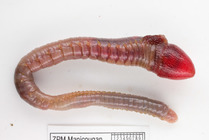WoRMS taxon details
Artacama Malmgren, 1866
129688 (urn:lsid:marinespecies.org:taxname:129688)
accepted
Genus
Artacama proboscidea Malmgren, 1866 (type by monotypy)
- Species Artacama benedeni Kinberg, 1867
- Species Artacama canadensis McIntosh, 1915
- Species Artacama challengeriae McIntosh, 1885
- Species Artacama coniferi Moore, 1905
- Species Artacama crassa Hartman, 1967
- Species Artacama globosa Hartman & Fauchald, 1971
- Species Artacama proboscidea Malmgren, 1866
- Species Artacama valparaisiensis Rozbaczylo & Méndez, 1996
- Species Artacama zebuensis McIntosh, 1885
marine, brackish, fresh, terrestrial
recent only
feminine
Malmgren, Anders Johan. (1866? vol for 1865). Nordiska Hafs-Annulater. [part three of three]. <em>Öfversigt af Königlich Vetenskapsakademiens förhandlingar, Stockholm.</em> 22(5): 355-410, plates XVIII-XXIX., available online at https://biodiversitylibrary.org/page/32339631
page(s): 394 [details]
page(s): 394 [details]
Etymology Not stated in the original description, but probably a Greek female given name, as Malmgren uses often ancient Greek female...
Etymology Not stated in the original description, but probably a Greek female given name, as Malmgren uses often ancient Greek female names for new genera in 'Nordiska Hafs-Annulater'. The genus is probably named after 'Artacama' or 'Artakama', a Persian noblewoman and second wife of Ptolemy I, the future ruler of Egypt and the first Pharaoh of the Ptolemaic dinasty, when he was still a general in the army of Alexander the Great. Artacama was a daughter of Artabazus of Phrygia and Queen Strateira. [details]
Read, G.; Fauchald, K. (Ed.) (2024). World Polychaeta Database. Artacama Malmgren, 1866. Accessed through: World Register of Marine Species at: https://www.marinespecies.org/aphia.php?p=taxdetails&id=129688 on 2024-04-24
Date
action
by
![]() The webpage text is licensed under a Creative Commons Attribution 4.0 License
The webpage text is licensed under a Creative Commons Attribution 4.0 License
original description
Malmgren, Anders Johan. (1866? vol for 1865). Nordiska Hafs-Annulater. [part three of three]. <em>Öfversigt af Königlich Vetenskapsakademiens förhandlingar, Stockholm.</em> 22(5): 355-410, plates XVIII-XXIX., available online at https://biodiversitylibrary.org/page/32339631
page(s): 394 [details]
basis of record Bellan, G. (2001). Polychaeta, <i>in</i>: Costello, M.J. <i>et al.</i> (Ed.) (2001). European register of marine species: a check-list of the marine species in Europe and a bibliography of guides to their identification. <em>Collection Patrimoines Naturels.</em> 50: 214-231. (look up in IMIS) [details]
additional source Fauchald, K. (1977). The polychaete worms, definitions and keys to the orders, families and genera. <em>Natural History Museum of Los Angeles County: Los Angeles, CA (USA), Science Series.</em> 28:1-188., available online at http://www.vliz.be/imisdocs/publications/123110.pdf [details]
additional source Glasby, Christopher J.; Read, Geoffrey B.; Lee, Kenneth E.; Blakemore, R.J.; Fraser, P.M.; Pinder, A.M.; Erséus, C.; Moser, W.E.; Burreson, E.M.; Govedich, F.R.; Davies, R.W.; Dawson, E.W. (2009). Phylum Annelida: bristleworms, earthworms, leeches. <em>[Book chapter].</em> Chapt 17, pp. 312-358. in: Gordon, D.P. (Ed.) (2009). New Zealand inventory of biodiversity: 1. Kingdom Animalia: Radiata, Lophotrochozoa, Deuterostomia. Canterbury University Press, Christchurch. [details] Available for editors [request]
[request]
page(s): 394 [details]
basis of record Bellan, G. (2001). Polychaeta, <i>in</i>: Costello, M.J. <i>et al.</i> (Ed.) (2001). European register of marine species: a check-list of the marine species in Europe and a bibliography of guides to their identification. <em>Collection Patrimoines Naturels.</em> 50: 214-231. (look up in IMIS) [details]
additional source Fauchald, K. (1977). The polychaete worms, definitions and keys to the orders, families and genera. <em>Natural History Museum of Los Angeles County: Los Angeles, CA (USA), Science Series.</em> 28:1-188., available online at http://www.vliz.be/imisdocs/publications/123110.pdf [details]
additional source Glasby, Christopher J.; Read, Geoffrey B.; Lee, Kenneth E.; Blakemore, R.J.; Fraser, P.M.; Pinder, A.M.; Erséus, C.; Moser, W.E.; Burreson, E.M.; Govedich, F.R.; Davies, R.W.; Dawson, E.W. (2009). Phylum Annelida: bristleworms, earthworms, leeches. <em>[Book chapter].</em> Chapt 17, pp. 312-358. in: Gordon, D.P. (Ed.) (2009). New Zealand inventory of biodiversity: 1. Kingdom Animalia: Radiata, Lophotrochozoa, Deuterostomia. Canterbury University Press, Christchurch. [details] Available for editors
 Present
Present  Inaccurate
Inaccurate  Introduced: alien
Introduced: alien  Containing type locality
Containing type locality
From editor or global species database
Classification Included in tribe Terebellini by Stiller et al (2020). Previously Holthe (1986) had placed it in a monotypic subfamily, Artacaminae [details]Diagnosis Original diagnosis by Malmgren (1866: 394). "Lobus cephalicus labium suborbiculatum nudum magnum antice fingens, plicis longitudinalibus profunde sinuatum, postice tentaculis numerosis canaliculatis inaequalibus versus apicem paulo incrassatis obsitus. Apertura oris ad basin labii anticam lobi cephalici sat parva, ab hoc et tentaculis prorsus occultata. Segmentura buccale antice in proboscidem papillosam caecam sat magnam productum. Oculi nulli. Branchiae filiformes breves numerosae, agminatim dorso segmenti secundi tertii et quarti utrinque adnatae, e centro vix elevato communi progerminantes. Fasciculi setarum capillarium a segmento quarto, h. e. tertio branchifero, incipientes in 17 segmentis. Setae capillares apice attenuato late limbatae. Tori uncinigeri a segmento quinto, h. e. secundo setigero, incipientes, post segmentum ultimum setigerum in pinnulas uncinigeras, supra lobulo magno subrotundato praeditas, mutati, usque ad segmentum anteanale obvias. Uncini minuti breves subaviculares, vertice sat elevato indistincte 4 — 5 serrulato, uniseriales, in segmento autem septimo uneinigere et 9 sequentibus biseriales." [details]
Etymology Not stated in the original description, but probably a Greek female given name, as Malmgren uses often ancient Greek female names for new genera in 'Nordiska Hafs-Annulater'. The genus is probably named after 'Artacama' or 'Artakama', a Persian noblewoman and second wife of Ptolemy I, the future ruler of Egypt and the first Pharaoh of the Ptolemaic dinasty, when he was still a general in the army of Alexander the Great. Artacama was a daughter of Artabazus of Phrygia and Queen Strateira. [details]
Grammatical gender Feminine, according to the ending of the specific epithet of Malmgren's type species, 'proboscidea'. Moreover, the genus is probably named after Artacama, a Persian noblewoman. [details]
